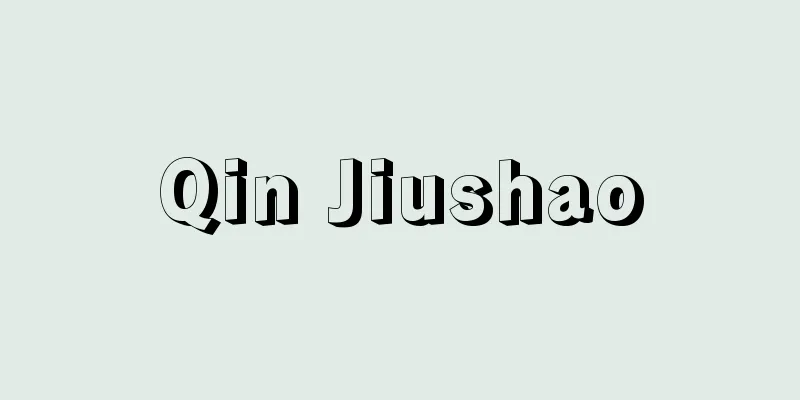Amemori Hoshu - Amemori Hoshu

|
Year of death: 1755.2.16 (5th year of the Horeki era) Year of birth: May 17, 1668 (June 26, 1668) A Confucian scholar of the Tsushima Domain in the mid-Edo period. Son of Kiyoharu. Commonly known as Togoro, and known in Korea as Amemori Azuma. Originally called Shunryo, he was later given one character of his given name by Tsushima Domain lord Mune Yoshimasa and called himself Seisei. His pen name was Hakuyo. His pen names were Hoshu, Tachibanado, and Shokeidō. He was born in Amemori, Takatsuki, Ika District, Omi Province (Shiga Prefecture), and some say he was born in Kyoto, where his father, a town doctor, had a practice. Due to his family background, he initially aspired to become a doctor, but eventually switched to Confucianism. It is said that he was influenced by the academic style of Kyoto at the time, which gave birth to Ito Jinsai and others. At the age of 18, he became a disciple of Kinoshita Junan in Edo, and was honored as one of the five teachers of the Kinomoto school along with Arai Hakuseki, Muro Kyūsu, and others. At the age of 22, he was recommended by his teacher to become a Confucian scholar of the Tsushima Domain. At the age of 26, he traveled to Tsushima and became a Korean advisor. Due to the nature of his role, he was involved in various matters related to Korea, so he learned Chinese and Korean again, accompanied the envoys to Edo as a literate official when they arrived in Japan, and also served as a diplomatic envoy and judge in Korea, becoming familiar with the practical aspects of Japan-Korea diplomacy, making him a unique scholar unlike any other Confucian scholar. He also made an effort in negotiations with the shogunate, arguing with Shiraishi, who became a political advisor to Tokugawa Ienobu, over the treatment of the envoys and the change of the title of king (1711), and from the standpoint of the trading domain of Tsushima, he engaged in an economic debate over silver exports (1714). In 1721, a case of smuggling by a Korean translator occurred within the domain, and the domain authorities tried to settle the matter peacefully and collude with the authorities, but together with his fellow Confucian scholar Matsuura Kasumi, he countered with the "Discussion on Smugglers," which called for strict punishment in order to eradicate smuggling in the future. At this time, his views were not accepted, so he resigned from his position as the head of the Korean government, handed over the family headship to his eldest son Akiyuki, and retired, resisting the authorities and taking a tough attitude toward the domain administration. Through these experiences, he continued to question what true exchange is, and eventually in his Korin Teisei (1728) he advocated the path of honest and sincere diplomacy, saying, "Sincere and sincere exchanges are when we do not deceive or argue with each other and interact honestly." Gentoku Jun, a translator who sympathized with this theory, took the opportunity to renovate the translator's building at the Wakan to name it "Seishin-do," and there is a famous anecdote in which Hoshu wrote Seishin-do-ki (Record of the Seishin-do) in response to his aspirations. He also highlighted the important role of interpreters in exchanges and tried to improve their working conditions, while in 1727 (Kyoho 12) he persuaded the domain to establish a Korean interpreter training school in Fuchu, Tsushima, in order to educate the next generation. Up until the Meiji period, this school produced many renowned interpreters, and with the ideal of cultivating interpreters who were intelligent, sincere, and learned, Hoshu's unique educational philosophy and methods were adhered to, such as using his own textbook, "Kourinsu-chi," and novels written in Hangul, which was not considered important at the time, as teaching materials. Even at the age of 80, his desire to learn was undiminished, and he recited the "Kokin Wakashu" 1,000 times, and was always busy composing poems with the goal of 10,000 poems himself. His works include "Tenryuin-ko Jitsuroku," "Korean Customs and Customs Study," "Zenichi Dojin," "Rinko Shimatsu Monogatari," "Jiyo Kanken," "Tachibanaso Chawa," "Tanabe Reigusa," and "Hoshu Eiso." <References> "Amemori Hoshu Complete Works," Nakamura Eiko, "Research on the History of Japan-Korea Relations," Vol. 2, Uegaito Kenichi, "Amemori Hoshu," Tashiro Kazuo, "Korean Interpreters in the Tsushima Domain" ("Shigaku," Vol. 60, No. 4) (Kazuo Tashiro) Source: Asahi Japanese Historical Biography: Asahi Shimbun Publications Inc. About Asahi Japanese Historical Biography |
|
没年:宝暦5.1.6(1755.2.16) 生年:寛文8.5.17(1668.6.26) 江戸中期の対馬藩の儒学者。清納の子。通称は東五郎,朝鮮では雨森東の名で知られる。初め俊良,のち対馬藩主宗義誠より諱の1字を与えられ誠清と称する。字は伯陽。号は芳洲,橘窓,尚絅堂。生まれは近江国(滋賀県)伊香郡高月の雨森,一説に町医者だった父が開業していた京都とも。生家の関係で初め医学を志すが,やがて儒学へ転向。伊藤仁斎らを生んだ当時の京都の学風に影響されたといわれる。18歳のころ江戸で木下順庵の門下に入り,新井白石,室鳩巣らと共に木門の五先生と尊称されるまでになり,22歳で師の推挙により対馬藩の儒者に就任。26歳で対馬に渡り,朝鮮方佐役となる。 役目柄,朝鮮関係の諸事にあずかるため,改めて中国語と朝鮮語を習得し,通信使来日に際しては真文役となって江戸へ随行,また参判使や裁判役など外交使節として朝鮮へ赴き日朝外交の実務に精通するなど,他の儒者にみられない異彩を放つ。幕府との折衝にも尽力し,徳川家宣の政治顧問となった白石と,通信使の待遇や国王号の改変を巡って議論を戦わせ(1711),貿易立藩対馬の立場から銀輸出にかかわる経済論争を展開(1714)。享保6(1721)年藩内に朝鮮訳官による密貿易事件が起こり,穏便に処理して癒着を図る藩当局に対し,同門の儒者松浦霞沼と共に,以後の密貿易根絶のため厳罰主義を内容とする「潜商議論」で反論した。このとき自説を容認されなかったため,朝鮮方佐役を辞任し,家督までも長男顕之允に譲って隠居を図るなどして当局に抵抗,藩政に対しても厳しい態度をもって臨んだ。 こうした体験を通じて,真の交流とは何かを常に問い続け,やがて『交隣提醒』(1728)に「互いに不欺,不争,真実を以て交り候を誠信とは申し候」とする誠信外交の道を説く。この持論に共感した訳官の玄徳潤は倭館の訳官屋改築の機会にこれを「誠信堂」と命名し,その志に対して芳洲が『誠信堂記』(1730)を著した逸話は有名である。また交流の場で重要な役割を果たす通訳に光を当て,その待遇改善を図る一方,享保12(1727)年,後進の教育のために藩を説得して朝鮮語通詞養成所を対馬府中に創設した。明治期まで多くの名通詞を輩出させるこの学校では,才智,篤実,学問を備えた通詞育成を理想に,自らの教科書『交隣須知』や当時軽視されていたハングルで書かれた小説を教材に用いるなど,芳洲独自の教育理念・方法が貫かれている。80歳を過ぎてなお向学心の衰えることなく,『古今和歌集』1千遍を誦じ,自らも1万首を目標に詠歌すること余念がなかった。著書に,『天竜院公実録』『朝鮮風俗考』『全一道人』『隣交始末物語』『治要管見』『橘窓茶話』『多波礼具佐』『芳洲詠草』などがある。<参考文献>『雨森芳洲全書』,中村栄孝『日鮮関係史の研究』下,上垣外憲一『雨森芳洲』,田代和生「対馬藩の朝鮮語通詞」(『史学』60巻4号) (田代和生) 出典 朝日日本歴史人物事典:(株)朝日新聞出版朝日日本歴史人物事典について 情報 |
<<: Ameba - Ameba (English spelling)
>>: Ame no Minakanushi no Kami
Recommend
Uji no Choja Senji - Order of the Head of Family
...One of the document styles from the Heian peri...
runner
...A rotating body consisting of multiple blades ...
Baule
...However, the way in which they do this varies ...
Occupational insurance/community insurance
There are two types of insurance: insurance groups...
Carex dolichostachya (English spelling)
…[Tetsuo Koyama]. … *Some of the terminology that...
Scomberomorus sinensis (English spelling) Scomberomorussinensis
…[Toru Taniuchi]. … *Some of the terminology that...
Khwaja Ahrar (English spelling)
...The doctrine and method of training were stric...
Dudeney, HE
...Figure 11-a shows how to cut a parallelogram i...
Side window lighting - 川村サンゴルゴ
…window [Lighting method and features] They are pr...
Gunflint - Gunflint
…It is also used as a flint, striking it with a p...
Glass thermometer
...A thermometer in which a liquid (a temperature...
Signature - Kanki
…When a painting or calligraphy is completed, the...
Cabral, Amilcar
Born: September 12, 1924 in Bafata Died January 20...
nosal speculum
… [Endoscope structure] Different instruments are...
Ephoros (English spelling)
[Born] 405 BC. Aeolis, Cyme [Died] 330 BCE An anci...









